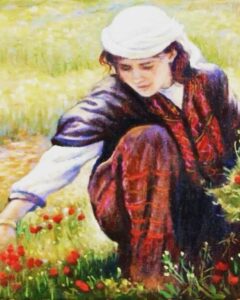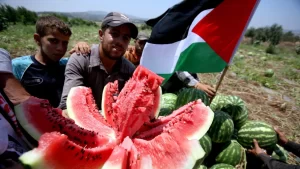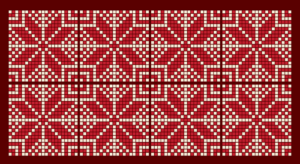Stories of Heritage, Resilience, and Identity “Symbols of Palestine”.
Palestinian culture is rich with symbols that carry deep historical and emotional significance. From geometric patterns in embroidery to the fruits of the land, each element tells a story of heritage, resilience, and identity. These symbols have been woven into art, literature, and daily life, preserving the Palestinian spirit through generations. Below are some of the most meaningful symbols that continue to inspire and connect Palestinians across the world.
1. The Eight-Pointed Star: A Symbol of Hope and Protection
The eight-pointed star, also known as the Star of Kanaan, is a traditional geometric motif found in Palestinian embroidery (tatreez) and architectural designs. This ancient symbol represents balance, renewal, and protection. It is believed to have originated from the Canaanite civilization and continues to be a recurring pattern in Palestinian culture today.
The Eight-Pointed Star in Art & Culture:
• Found in traditional Palestinian dresses, especially in tatreez embroidery.
• A decorative element in ancient Palestinian architecture and ceramics.
• Used in modern Palestinian jewelry and digital art as a symbol of resilience.
2. The Oranges of Yaffa: A Lost Harvest
Once famous worldwide, the oranges of Yaffa (Jaffa) symbolize the prosperity of Palestine before 1948. The city was a major citrus exporter, known for its lush orange groves. Today, the orange is a bittersweet reminder of what was lost during the Nakba, representing displacement and longing for return.
The Oranges of Yaffa in Art & Culture:
• Often depicted in paintings and murals as a symbol of Palestinian heritage.
• Featured in poetry and literature as a metaphor for loss and nostalgia.
• A recurring motif in Palestinian embroidery, especially in coastal region patterns.
3. The Red Roses of Gaza: Beauty Amidst Struggle
Despite its hardships, Gaza is known for its stunning red roses, which thrive in its fertile soil. These roses symbolize love, resilience, and the enduring spirit of the Palestinian people. They are a testament to life’s ability to flourish even under siege.

The Red Roses of Gaza in Art & Culture:
• A symbol of hope and beauty in Palestinian literature and poetry.
• Depicted in paintings and murals as a contrast to the hardships of war.
• Sold in local markets and exported, showcasing Gaza’s agricultural richness.
4. The Red Anemone (Poppy): The Flower of Martyrs
The red anemone, also called the Palestinian poppy, is known as the “Flower of Martyrs.” Its deep red color represents the blood of those who have sacrificed for their homeland. It blooms across Palestine in spring, symbolizing resistance and remembrance.

The Red Anemone in Art & Culture:
• Frequently appears in poetry and folk songs as a symbol of martyrdom.
• Painted in murals and artwork honoring Palestinian heroes.
• Worn as a national emblem in remembrance of fallen loved ones.
5. The Bread Rings of Jerusalem: A Taste of Tradition
The sesame-crusted bread rings of Jerusalem (Ka’ak Al-Quds) are an iconic Palestinian street food. These golden-brown rings, sold by vendors throughout the Old City, symbolize hospitality and Palestinian culinary heritage.

The Bread Rings in Art & Culture:
• Commonly depicted in paintings and photographs of Jerusalem.
• Celebrated in Palestinian literature as a nostalgic taste of home.
• Served during gatherings, embodying warmth and tradition.
6. The Watermelon: A Hidden Flag
During times when the Palestinian flag was banned, Palestinians used the watermelon as a silent act of resistance. With its red, black, white, and green colors, the watermelon symbolized national pride and defiance.

The Watermelon in Art & Culture:
• A recurring theme in contemporary Palestinian protest art.
• Used in digital art and graffiti as a hidden message of resistance.
• Often featured in social media campaigns supporting Palestinian identity.
These symbols, rooted in Palestinian history and daily life, continue to serve as powerful reminders of identity, resilience, and cultural heritage. Whether through embroidery, poetry, or street art, they carry the voices of generations past and present, ensuring that the Palestinian story lives on.




5 comments